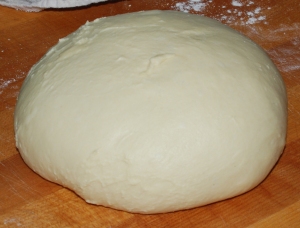 I have not made rolls in a while, so I figured it was time to give it a go. I was going to make some straight onion rolls from the recipe in Inside the Jewish Bakery by Stanley Ginsberg and Norman Berg, but I decided to try something a little different. I used the onion topping recipe from the book and created a nice soft dough using some smooth style ricotta, whole eggs and a combination of durum flour and bread flour. To make it interesting I used my usual amount of white starter at 65% hydration to create a beautiful smooth and silky dough that smelled good enough to eat by itself before baking.
I have not made rolls in a while, so I figured it was time to give it a go. I was going to make some straight onion rolls from the recipe in Inside the Jewish Bakery by Stanley Ginsberg and Norman Berg, but I decided to try something a little different. I used the onion topping recipe from the book and created a nice soft dough using some smooth style ricotta, whole eggs and a combination of durum flour and bread flour. To make it interesting I used my usual amount of white starter at 65% hydration to create a beautiful smooth and silky dough that smelled good enough to eat by itself before baking.
These rolls are great with or without the onion topping, and are nice and light and airy with a slight sourdough flavor.
Ingredients
Dough
15 oz. Refreshed Starter (65% Hydration)
4 Large Eggs lightly beaten, (8 oz. total liquid)
5 oz. Smooth Style Ricotta (you can use regular style or fresh if you can make it)
6 oz. Water (90 degrees F.)
11 oz. Durum Flour (King Arthur Flour or similar)
9 oz. Bread Flour (King Arthur Flour or similar)
2.5 Tsp. Salt, .63 oz. (Sea salt or table salt)
Onion Topping
1/2 cup, 1.5 oz. Dehydrated chopped onions
1 1/2 cups,12 oz., Boiling water
1 Tbs., .5 oz. Vegetable oil
1 1/2 tsp., .3 oz., Black poppy seeds
1/4 tsp., .1 oz., Table salt or sea salt
Directions
Cut the starter into about 8 pieces and mix the eggs and water with the starter to break it up. Next add the rest of the ingredients and mix either using your stand mixer on low-speed for 2 minutes. Let the dough rest for 5 minutes and then mix on medium speed for 4 minutes. If necessary add some additional liquid or flour until the dough comes together in a nice silky and smooth ball.
Take the dough out of the bowl and place on your work surface. Knead it by hand for 1 minute and form it into a ball. Let it rest for 10 minutes. After 10 minutes do a stretch and fold from all sides and form it into a ball again. Let it rest another 10 minutes and then do 1 additional stretch and fold and immediately put it in a lightly oiled bowl. Cover the bowl and let it rest at room temperature around 70 degrees F. for 2 hours. After 2 hours put it in your refrigerator for 1-3 days.
Either the day before or while the dough is resting, prepare the onion filling. Pour the boiling water into a bowl with the dehydrated onions and let sit for around 30 minutes. Drain through a strainer and spread out on a paper towel to absorb as much moisture as possible. Mix the onions with the remaining ingredients and either refrigerate in a sealed container or bag or use when cool.
When you are ready to make your rolls take the dough out of the refrigerator and keep it in its bowl at room temperature for 2 hours. After 2 hours the dough should be ready to shape. Using a piece of parchment paper or cookie sheet place about 1/2 of the prepared onion mixture on your surface of choice. Cut the dough into 3 oz. pieces and form round rolls making sure each roll is nice and tight. Press the top of each roll into the onion mixture and place a cookie sheet with parchment paper. Cover the rolls with a clean lint free towel sprayed with water or a piece of plastic wrap lightly sprayed with cooking spray. Let the rolls rest at room temperature for 2 hours.
Around 30 minutes before baking the rolls, prepare your oven and pre-heat at 425 degrees. I used my usual set-up for steam and added 1 cup of boiling water to a pan on the bottom shelf but for rolls you could omit this step and you will get softer rolls if that is what you desire.
It should take around 20-25 minutes to bake the rolls and they should be nice and brown on the bottom and top. When done, let them cool on a wire rack and enjoy.This post has been submitted to Yeast Spotting at http://www.wildyeastblog.com/category/yeastspotting.
As you can see the crumb is nice and open and airy.


















